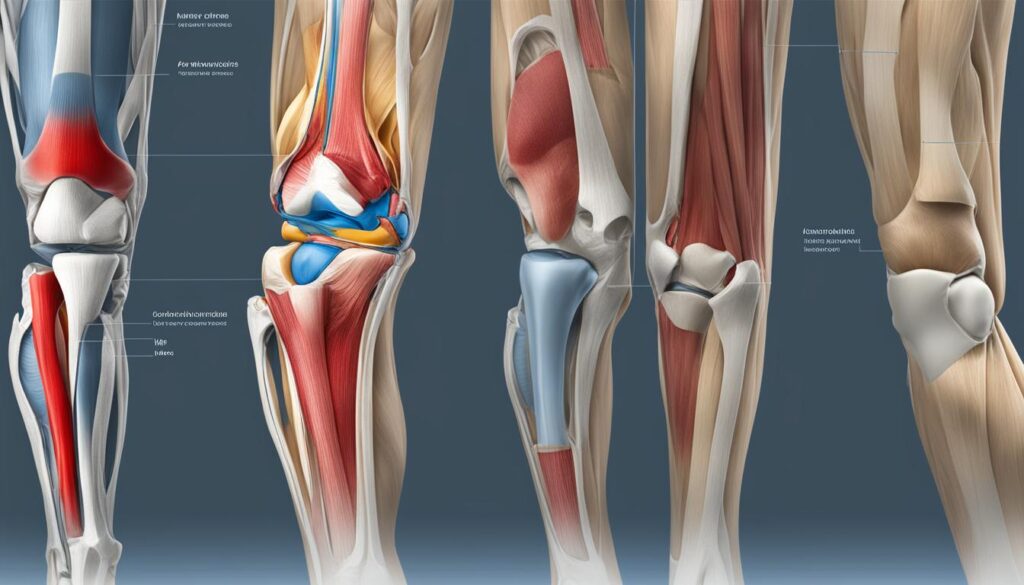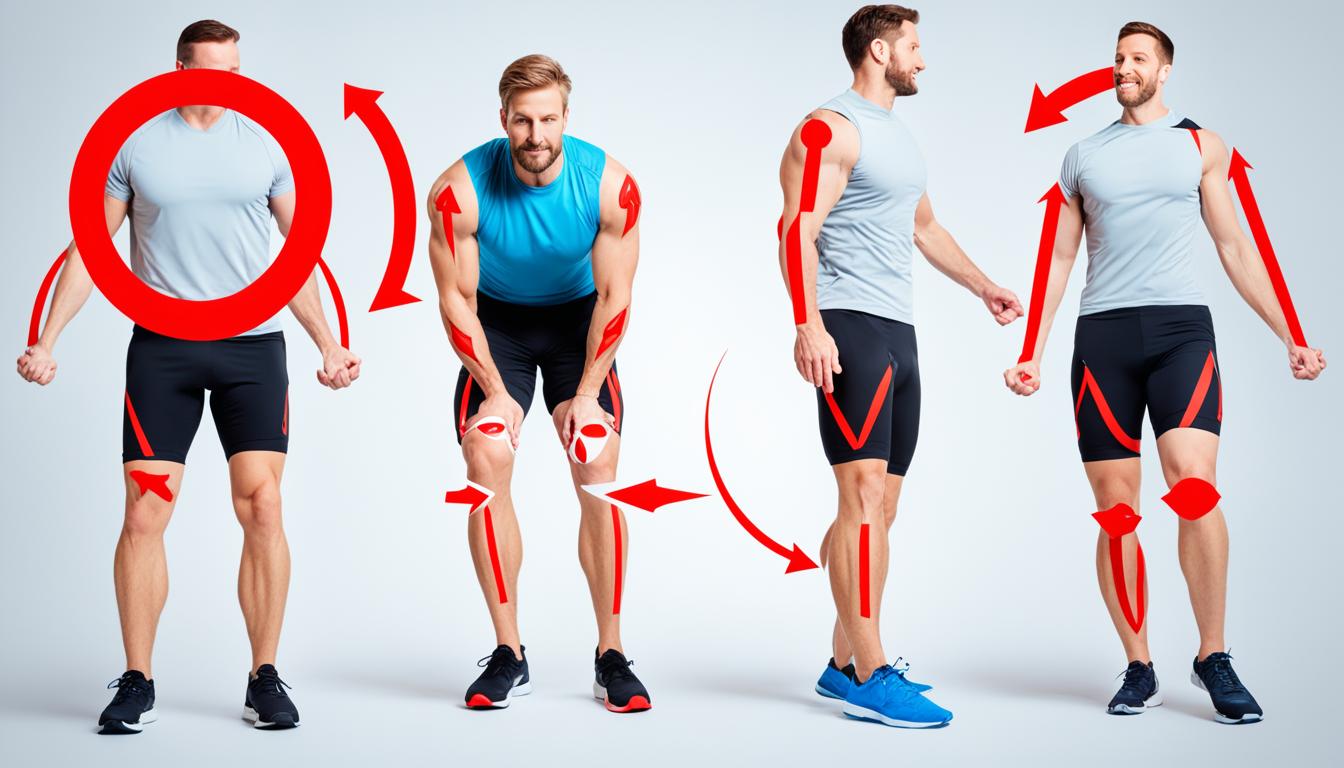Understanding Knee Injuries: Causes Explained
Did you know that knee injuries are one of the most common musculoskeletal problems, affecting millions of people worldwide?
From professional athletes to everyday individuals, knee injuries can occur due to a variety of reasons and impact people of all ages and activity levels. In this article, we will dive into the causes of knee injuries, explore common types of injuries, discuss symptoms, and highlight the importance of treatment and rehabilitation.
Whether you have experienced a knee injury yourself or want to learn more about how to prevent them, our comprehensive guide will provide you with valuable insights and knowledge. Let’s get started!
Common Knee Injuries and Symptoms
When it comes to knee injuries, there are several common types that individuals may experience. These include sprains, ligament tears (such as ACL and PCL tears), fractures, dislocations, meniscal tears, and tendon tears. Each of these injuries can cause significant pain and discomfort, affecting a person’s mobility and overall quality of life.
Knee injuries can manifest themselves through various symptoms. The most obvious symptom is knee pain, which can be sharp, dull, or throbbing depending on the injury. Swelling and stiffness are also common symptoms, making it difficult for individuals to fully bend or straighten their knees. Furthermore, knee injuries can result in instability, making it challenging to bear weight or engage in physical activities without discomfort.
It’s important to note that knee injuries can present themselves differently depending on the specific type and location of the injury. For instance, a ligament tear may cause a popping sound at the time of injury, while a fracture may lead to visible deformity in the leg or knee. In some cases, knee injuries may also result in redness, warmth to the touch, weakness, or other abnormal sensations.
If you experience severe pain, an inability to bear weight, difficulty fully moving your knee, or noticeable swelling at the site of the injury, it is essential to seek medical attention for a proper diagnosis and treatment. A healthcare professional will assess your symptoms, conduct a comprehensive examination, and may recommend additional tests or imaging to accurately diagnose your knee injury.
| Knee Injury | Symptoms |
|---|---|
| Sprains | Pain, swelling, instability |
| Ligament Tears (ACL/PCL) | Pain, swelling, instability, popping sound |
| Fractures | Pain, swelling, visible deformity |
| Dislocations | Pain, swelling, instability |
| Meniscal Tears | Pain, swelling, difficulty bending knee |
| Tendon Tears | Pain, weakness, limited range of motion |

Case Study: ACL Tear
“The ACL tear was a turning point in my athletic journey. The pain was excruciating, and I couldn’t even walk without support. It was a wake-up call about the importance of protecting my knees and taking care of my body.” – Sarah Thompson, former collegiate soccer player
Treatment and Rehabilitation of Knee Injuries
When it comes to knee injuries, the appropriate treatment and rehabilitation strategies can make a significant difference in the recovery process. The choice of treatment depends on the severity and specific type of injury.
In cases where the injury is less severe, nonsurgical treatments are often the preferred approach. These treatments may include:
- Rest: Allowing the injured knee to heal by minimizing weight-bearing activities.
- Immobilization: Using a brace or cast to keep the knee stabilized and protected during the healing process.
- Physical therapy: Engaging in exercises and stretching techniques to strengthen the muscles around the knee, improve flexibility, and restore normal range of motion.
- Nonsteroidal anti-inflammatory drugs (NSAIDs): Taking medication to manage pain and reduce inflammation in the knee.
However, in more severe cases, surgical intervention may be necessary. Fractures or complete ligament tears often require surgical treatment to restore stability and promote proper healing. Surgical options can vary depending on the specific injury and may include arthroscopic procedures or open surgery.
Regardless of the chosen treatment path, rehabilitation plays a critical role in the recovery process. Through a structured rehabilitation program, the muscles around the knee are targeted for strengthening, flexibility and range of motion are improved, and activity levels are gradually increased.
It is essential to follow the recommendations of healthcare professionals and diligently complete the prescribed rehabilitation program. Consistency and adherence to the program are key to proper healing and preventing future knee problems.
| Treatment | Benefits |
|---|---|
| Nonsurgical treatments |
|
| Surgical treatments |
|
| Rehabilitation |
|
Conclusion
Knee injuries can occur due to various factors, including trauma, participation in sports activities, and underlying medical conditions. Understanding the causes of knee injuries is essential for taking preventive measures and reducing the risk of such injuries. By maintaining a healthy weight, engaging in proper conditioning and strength training, and using correct techniques during physical activities, individuals can significantly lower their chances of experiencing knee injuries.
Prompt medical attention and appropriate treatment are critical in the management and recovery of knee injuries. It is important to consult with healthcare professionals to develop an effective treatment plan tailored to the specific injury. Following their recommendations and adhering to prescribed rehabilitation programs are vital for restoring knee function and preventing future knee problems.
Rehabilitation plays a crucial role in the recovery process of knee injuries. Through targeted exercises and therapy, rehabilitation helps strengthen the muscles around the knee, improves flexibility and range of motion, and gradually increases activity levels. Adhering to the prescribed rehabilitation programs not only aids in proper healing but also reduces the risk of future knee complications.
In conclusion, understanding the risk factors for knee injuries, seeking prompt medical attention, and diligently following recommended treatment and rehabilitation programs are essential for minimizing the impact of knee injuries. By taking proactive steps to prevent knee injuries and focusing on proper care and rehabilitation, individuals can maintain optimal knee health and overall well-being.
FAQ
Why are knee injuries so common?
The knee is a complex joint, making it vulnerable to various injuries such as sprains, ligament tears, fractures, and dislocations. Factors such as trauma, forceful twisting, high-impact accidents, and sports-related activities contribute to the high occurrence of knee injuries.
What are the common causes of knee injuries?
Knee injuries can be caused by trauma from falls, forceful twisting of the knee, high-impact accidents, and participation in sports-related activities. Other contributing factors include excess weight, lack of muscle flexibility and strength, prior knee injuries, participation in high-risk sports, and certain medical conditions.
How can knee injuries be prevented?
Many knee injuries can be prevented by proper conditioning, strength training, using proper techniques during physical activities, and maintaining a healthy weight. It is important to engage in exercises that improve leg strength and flexibility while avoiding excessive stress on the knee joint.
What are the common knee injuries and their symptoms?
Common knee injuries include sprains, ligament tears (such as ACL and PCL tears), fractures, dislocations, meniscal tears, and tendon tears. Symptoms of knee injuries may include pain, swelling, stiffness, instability, popping or crunching noises, and an inability to fully straighten the knee. The location and severity of knee pain may vary depending on the specific injury, and in some cases, knee injuries may also cause redness, warmth to the touch, weakness, and a visible deformity in the leg or knee.
When should I seek medical attention for a knee injury?
It is important to seek medical attention if you experience severe pain, an inability to bear weight or fully move the knee, or if there is significant swelling at the injury site. These symptoms may indicate a more serious knee injury that requires professional evaluation and treatment.
How are knee injuries diagnosed and treated?
Diagnosis of knee injuries typically involves a physical examination, medical history review, and imaging tests such as X-rays, MRI, or CT scans. Treatment for knee injuries depends on the severity and specific type of injury. Nonsurgical options may include rest, immobilization with a brace or cast, physical therapy, and the use of nonsteroidal anti-inflammatory drugs (NSAIDs) to reduce pain and swelling. Surgical treatment may be required for more severe injuries, such as fractures or complete ligament tears, and can involve arthroscopic procedures or open surgery depending on the specific injury.
How important is rehabilitation in the recovery process?
Rehabilitation plays a crucial role in the recovery process for knee injuries. It focuses on strengthening the muscles around the knee, improving flexibility and range of motion, and gradually increasing activity levels. Following the recommendations of healthcare professionals and completing the prescribed rehabilitation program is essential for proper healing and preventing future knee problems.
Can knee injuries be caused by factors other than physical trauma?
While physical trauma is a common cause of knee injuries, underlying medical conditions and repetitive stress on the knee joint can also contribute to knee injuries. Conditions such as arthritis and tendinitis can weaken the knee joint and increase the risk of injury.
What are the risk factors for knee injuries?
Risk factors for knee injuries include excess weight, lack of muscle flexibility and strength, participation in high-risk sports or activities that involve repetitive knee movements, previous knee injuries, and certain medical conditions. Understanding these risk factors can help individuals take preventive measures to reduce their chances of sustaining a knee injury.
Are knee injuries preventable?
While it may not be possible to completely eliminate the risk of knee injuries, many can be prevented with proper conditioning, strength training, using correct techniques during physical activities, and maintaining a healthy weight. By addressing the risk factors and adopting preventive measures, individuals can reduce their susceptibility to knee injuries.







